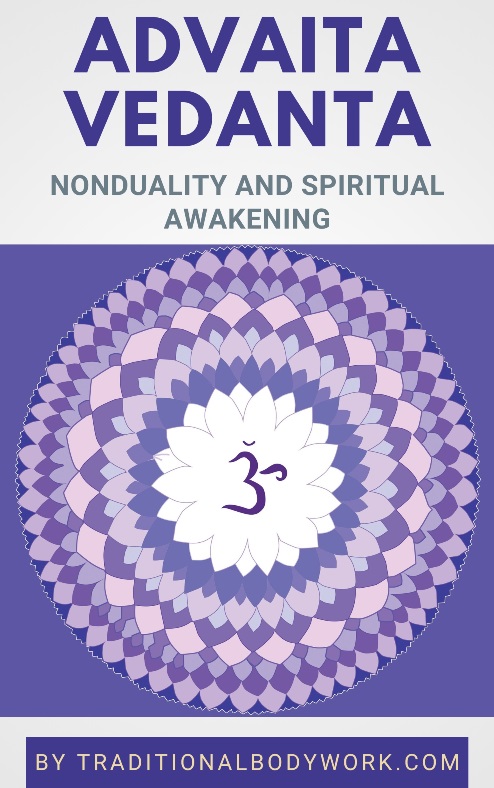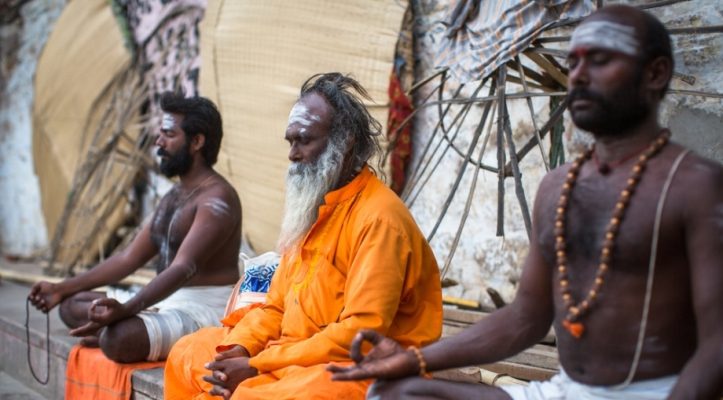
Mantras — also written Mantrams — as used in Hinduism and Buddhism, are sacred sounds, utterances, words, or sentences in the Sanskrit, Pali or other ancient languages, of which it’s believed that they have religious, magical, healing, or spiritual powers. Some mantras have a specific literal meaning, but many don’t have any (semantic) meaning at all.
Although the use of mantras is usually connected with Hinduism and Buddhism, similar practices of repeatedly uttering words or phrases can be found in Taoism, Christianity, and Shamanism, among other spiritual traditions.
Table of contents:
⦿ Use and Function of Mantras
⦿ Mantras in the West
⦿ Well-Known Mantras – Examples
Etymology of the Word Mantra
The Sanskrit word “Mantra” is a combination of two other words “man” and “tra.” Man can have different meanings, such as “to think,” “to sound,” “to worship,” “to consider,” “to respect,” “to know,” among others.
Tra is usually understood as “instrument” or “tool,” but it may also mean “to protect” or “to save.” The extension tra is well-known from the word Tantra as in “Tan-tra,” where it has the same meaning of “technique” or “instrument.”
As such, the literal meaning of “Mantra” would mean something that is meditated on, a tool for meditation, reflection, protection, salvation, perception and/or deep thinking. Nevertheless, it should be said that it’s still under debate what exactly the literal meaning of the word “Mantra” is, that is, the scholars haven’t yet come to a common consensus.
Use and Function of Mantras
Mantras can be chanted (sung), spoken aloud, written down, or silently uttered in the mind, typically being repeated for a certain duration or a specific number of times.

They may be used to meditate or reflect on to reveal their deeper meaning, such as is the case with the Mahavakyas in Advaita Vedanta.
Mantra applications can also be found in many types of Yoga, typically being part of Yogic techniques that calm and still the mind in order to come to Dharana (single-pointed concentration) and subsequently Dhyana (deep meditation).
It can also be a devotional Yogic practice — Bhakti Yoga — in order to worship a Deity and/or ask for help, a means to induce altered states of consciousness, a certain emotional state, or ambiance, or they may be used solely for the vibrations of the sounds to benefit from the therapeutic properties of their inner resonance, either for physical, psychological, or spiritual healing.
When repeating mantras is the sole form of spiritual practice, one could say that the practitioner practices Mantra Yoga, which is often equated with Japa Yoga practice. Mantra Yoga is thought to be such a unique and powerful form of Yoga that it’s considered a separate type, named as a distinct form in the Shiva Samhita (an authoritative Hindu Sanskrit treatise on Yoga), alongside Laya Yoga, Hatha Yoga, and Raja Yoga.
The types of mantras and their particular functions and uses depend very much on the spiritual lineage. For instance, within Tantric traditions they may be used as part of personal Tantric initiation rituals (typically given by a Tantra Master), or serve as important spiritual tools in practices like Tantra Yoga, Chakra Awakening, and Kundalini Yoga.
Yantras (mystical diagrams, paintings, murals or symbols thought to have occult powers) and mantras are often found in conjunction, because sound (the mantra) is considered an inseparable part of form (the yantra), just as energy and matter are considered two sides of the same coin and only different aspects of universal manifestation.
Mantras in the West
Apart from the use of mantras as described in the previous paragraph, the word Mantra has also gained some traction in many Western languages.
In the West, it often refers to a certain phrase that’s said frequently and is deliberately repeated to underline a strong belief or conviction, like a type of slogan or motto used by organizations, companies, or individuals.
For instance, you would encounter it as a “Company Mantra” or “Brand Mantra.” Think of phrases or mottos like “The Customer Is the Most Important Person in the Room,” “Do the Right Thing,” “Think Different,” or “All it Takes Is All You’ve Got,” and so on.
Well-Known Mantras – Examples
In this paragraph we give you examples of some well-known (spiritual) Mantras.

Aum (Om)
The spiritual mantra Om (Aum) originates in Hinduism and is perhaps the best known mantra around the world. The sound Aum (Om, Ohm) is considered the first and most sacred sound, and represents the creation of the Universe as an emanation of the first “Breath” of the Divine Creative Energy, God, or Brahman (this first breath is thought to sound like the word Aum).
Aum is a spiritual incantation used before and during recitations of spiritual texts, during Pujas and prayers, in a broad variety of Hindu ceremonies, and during meditative and spiritual activities. It’s thought that by meditating on Aum one can reach deeper levels of awareness, finally coming to Divine Union with Brahman.
Om Mani Padme Hum
Om Mani Padme Hum is a Sanskrit phrase and an important Buddhist mantra (notably in Tibet, Mongolia, and China), which is usually translated as “Praise to the Jewel in the Lotus.” Mind that the first word “Om” is actually the Aum (Om) Mantra previously described.
The meaning of this mantra is interpreted very differently across spiritual lineages and scholars, and can be just vocative and emotive, devotional (worshiping the name of a certain Deity or Bodhisattva), an inner meaning (of the words) referring to Spiritual Enlightenment, a pointer to the powers of the Yoni or to Kundalini Energy i.e. Shakti Energy, a path to Spiritual Liberation, a tool for Spiritual Purification, among other meanings.
Gayatri Mantra

The Gayatri Mantra is known as “Om bhur bhuvah svaḥ tat savitur vareṇyaṃ bhargo devasya dhimahi dhiyo yo naḥ pracodayat,” and is an important, very widely used Hindu mantra in India that invokes and worships the Universal Brahman as the principle of knowledge and spiritual illumination. The source of this mantra is found in the Rig Veda (an ancient holy Hindu scripture).
There are really many translations of this mantra, such as “Let us meditate on the excellent glory of the Divine Light (the Sun); may He stimulate our understandings,” “We meditate on the glory of that Being who has produced this Universe; may She enlighten our minds,” or “We meditate on the glory of Ishvara (the manifest Brahman); may He inspire our understanding.”
In any case, it’s believed that those who recite this mantra will receive Spiritual Wisdom and Enlightenment through the Universal Divine Principle, the Absolute, which is the source, but also the creative and manifest power of/in the Universe.














